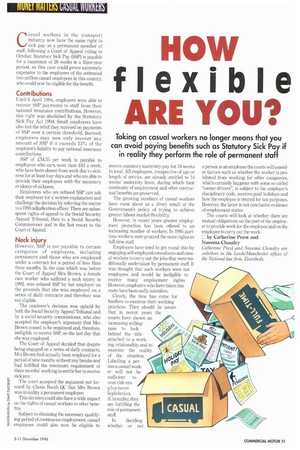HOW flexible ARE YOU?
Page 33

If you've noticed an error in this article please click here to report it so we can fix it.
Taking on casual workers no longer means that you can avoid paying benefits such as Statutory Sick Pay if in reality they perform the role of permanent staff
Casual workers in the transport industry now have the same right to sick pay as a permanent member of staff, following a Court of Appeal ruling in October. Statutory Sick Pay (SSP) is payable for a maximum of 28 weeks in a three-year period, so this case could prove extremely expensive to the employers of the estimated two million casual employees in this country, who could now be eligible for the benefit.
Contributions
Until 6 April 1994, employers were able to recover SSP payments to staff from their national insurance contributions. However, this right was abolished by the Statutory Sick Pay Act 1994. Small employers have also lost the relief they received on payments of SSP over a certain threshold. Instead, employers may now only recover any amount of SSP if it exceeds 13% of the employer's liability to pay national insurance contributions.
SSP of £54.55 per week is payable to employees who earn more than £61 a week, who have been absent from work due to sickness for at least four days and who are able to provide their employers with the necessary evidence of sickness.
Employees who are refused SSP can ask their employer for a written explanation and challenge the decision by referring the matter to a DSS adjudication officer. There are subsequent rights of appeal to the Social Security Appeal Tribunal, then to a Social Security Commissioner and in the last resort to the Court of Appeal.
Neck injury
However, SSP is not payable to certain categories of employees, including pensioners and those who are employed under a contract for a period of less than three months. In the case which was before the Court of Appeal Mrs Brown, a female care worker who suffered a neck injury in 1992, was refused SSP by her employer on the grounds that she was employed on a series of daily contracts and therefore was not eligible.
The employer's decision was upheld by both the Social Security Appeal Tribunal and by a social security commissioner, who also accepted the employer's argument that Mrs Brown ceased to be employed and, therefore, ineligible to receive SSP, on the last day that she was employed.
The Court of Appeal decided that despite being engaged on a series of daily contracts, Mrs Brown had actually been employed for a period of nine months without any breaks and had fulfilled the minimum requirement of three months' working to entitle her to receive sick pay.
The court accepted the argument put forward by Cherie Booth QC that Mrs Brown was in reality a permanent employee.
This decision could also have a wide impact on the rights of casual workers to other benefits.
Subject to obtaining the necessary qualifying period of continuous employment, casual employees could also now be eligible to receive statutory maternity pay for 18 weeks in total. All employees, irrespective of age or length of service, are already entitled to 14 weeks' maternity leave, during which their continuity of employment and other contractual benefits are preserved.
The growing numbers of casual workers have come about as a direct result of the Government's policy of trying to achieve greater labour market flexibility.
However, in recent years greater employment protection has been offered to an increasing number of workers. In 1995 parttime workers were granted the same rights as full-time staff.
Employers have tried to get round this by engaging self-employed consultants and casual workers to carry out the jobs that were traditionally undertaken by permanent staff. It was thought that such workers were not employees and would be ineligible to receive many employment rights. However, employers who have taken this route have been sadly mistaken.
Clearly, the time has come for hauliers to examine their working practices. They should be aware that in recent years the courts have shown an increasing willingness to look behind the title attached to a working relationship and to examine the reality of the situation. Labelling a person a casual worker will not be sufficient to over-ride employment legislation if, in reality, they are fulfilling the role of permanent staff.
In deciding whether or not a person is an employee the courts will consider factors such as whether the worker is prohibited from working for other companies, which certainly happens with some so-called "owner-drivers", is subject to the employer's disciplinary code, receives paid holidays and how the employee is treated for tax purposes. However, the latter is not conclusive evidence of employment status.
The courts will look at whether there are mutual obligations on the part of the employer to provide work for the employee and on the employee to carry out the work.
0 by Catherine Prest and Naeema Choudry
Catherine Prest and Naeerna Choudry are solicitors in the Leeds/Manchester offices of the National late firm, Eversheds.








































































































